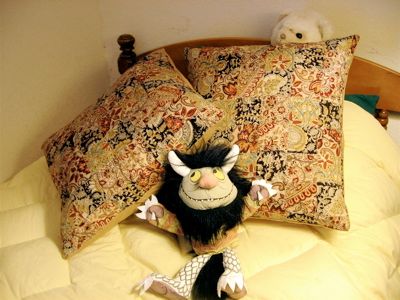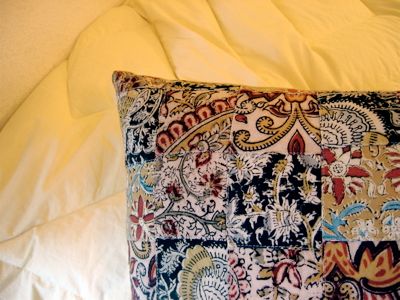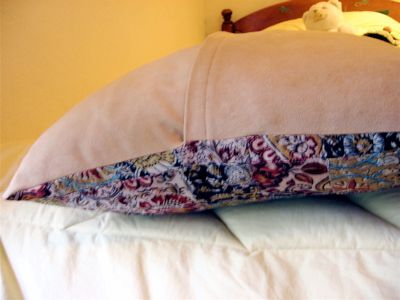
This weekend, I made some 18 x 18-inch throw pillows for my sister's new apartment. She admired this patchwork cotton from Gorgeous Fabrics, and asked for a neutral solid on the other side, with a split-back design for easy removal and cleaning. I chose a machine-washable polyester faux suede for the backs. I got these fabrics on clearance a couple of weeks ago. They are on sale again until midnight Eastern time today for Gorgeous Fabrics' Memorial Day sale, along with many other patchwork cottons and other great fabrics. If you miss this sale, though, rest assured that there will be another sale soon--that's one of many great things about Gorgeous Fabrics.
It took one yard of each fabric to make the pair of pillow covers. [CORRECTION: It only took just over a half-yard of the patchwork and a half-yard of the 'doeskin' for this project; I have a half-yard or so of each left over, and I bought one yard of each. Gorgeous Fabrics cuts generously. I have enough fabric left over to make my other sister a great little bag!]
Instructions and more views below the fold, including a close-up of the patchwork fabric.
The PillowsXpress website admonished me to choose a pillow insert 2 inches bigger on a side than my finished case size, so I got two 20"-square pillow inserts in their Perma Soft variety. You could also go green with a bamboo-filled pillow insert, or make your own with bamboo or corn fiberfill.
I happened to do this project in inches, but it's easy to convert to centimeters and vice versa.
I used 1/2-inch seam allowances, so I cut a 19" square of freezer paper as a pattern for the pillow fronts. The backs were the same height, and the formula for calculating the width of the split back pattern pieces is easy: the front width plus 5 inches, divided by 2. So in this case that came out to 19 inches high by 12 inches wide for the back pieces.
I cut one front piece of patchwork and two back pieces of faux suede for each pillow cover.
First, I did a double-fold hem on one long side of each back piece by pressing a quarter-inch of fabric to the wrong side, then folding and pressing again to make it a full inch. I then topstitched close to the fold.
It helps to have a grid for this next part. My mother has a rotary-cutting mat with a 1-inch square grid on it. I laid out the hemmed back pieces right side up on my grid, overlapping the hemmed edges at the center by three inches. I then checked that my final total width was indeed 19" and pinned the overlaps together at top and bottom.
Then, I laid the front piece right side down on the back and pinned it all together. I sewed all four sides with a straight stitch, then did that again just outside the first line of stitching. I also reinforced the places where the back pieces overlap with a third row of stitches. This would all go faster on a serger/overlock machine, of course, if you happen to have one.
To help minimize "pillow-ears", I ran a few stitches straight across each corner, then clipped the corners. Finally, I pressed the heck out of the whole thing, using a seam roll to press seam allowances to the back.

The corner only has a little bit of a "dog-ear", which strangely enough looks graceful with the square patchwork here, I think.
I like the shape of these pillow corners, but if you have zero tolerance for dog-ears on your throw pillows, try tapering the corners of your pattern or invest in a pillow template, which has multiple sizes and a nice taper to the corners. For more on pillow-making and corner-tapering, read this great pdf article excerpted in Threads magazine: Great Pillows 1-2-3.

Here's the nifty split back in poly faux suede. This polyester is pre-fused to a nylon interfacing and would make a great trench coat too.
I am also at work on a pair of 12"x 22" pillows for The Lady Eve's new place, using both faces of a great heavy reversible starburst-print denim. I'll show y'all how they turn out when I eventually get to finish them.
EDIT: total cost for this project (including shipping charges for fabric and pillow inserts) was about $12 per pillow. One could cut costs by using less expensive fabric, but this still beats retail prices for 18" throw pillows of this quality.




Shakesville is run as a safe space. First-time commenters: Please read Shakesville's Commenting Policy and Feminism 101 Section before commenting. We also do lots of in-thread moderation, so we ask that everyone read the entirety of any thread before commenting, to ensure compliance with any in-thread moderation. Thank you.
blog comments powered by Disqus